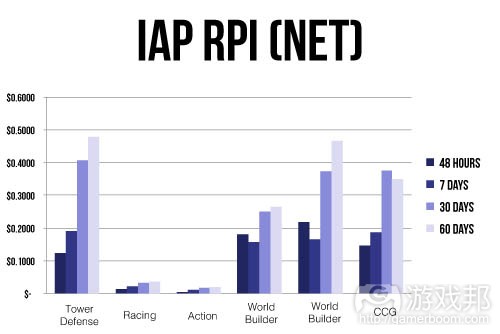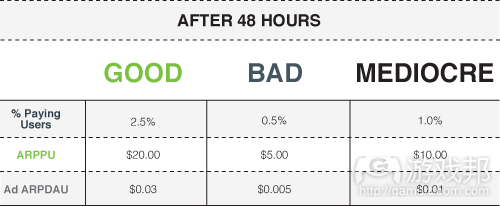如何在48小时内知道游戏是否成功?
作者:Jon Walsh
虽然大家都知道你应该至少收集到30天的参数,才可能判断自己游戏的长期发展潜力,但我们认为你密切关注游戏发布48小时后的一些早期指标就可以预知一二了。
我们收集了成百上千款游戏,成百上千万次安装量等数据来判断发行商可以在游戏发布仅48小时后掌握的一些情况。在经过一些具体的分析后,我们发现有一些关键参数可以让你预知自己游戏的未来玩家价值等情况。这些参数还可以引导发行商采取特定的调整措施来挽回潜在损失。而这些调整都必须在30天之前执行妥当。分析头48小时的参数不但有助于你预测自己的命运,为你提供清晰的操作指南,还可以让你早点知道自己应该采取的行动。
在48小时后,你一般都已经获得了足够的玩家从而观察他们的游戏行为,例如他们是否会重返游戏,更重要的是,他们是否在游戏中消费。玩家获取、会话时间长短、重返率,转化率以及进程等特定参数可揭露出你的不足之处,为你实现目标提供明确的方向。
我们的分析过程中查看了一系列游戏头60天在全球的发布情况。分别对照了它们在48小时,7天,30天和60天的相关数据。第60天的数据就可以成为你的玩家终身价值的指标。
为统一不同题材和游戏生命周期的参数,其中有些数据用于衡量60天的预期值。这里的游戏依题材进行分组。
基本的经济和重要参数
当然,最基础的算术就是,你的玩家价值必须高于玩家成本。在本文我们关注的是玩家价值的等式。我们查看的48小时后以及可预计60天后游戏发展情况的参数包括:
*IAP转化率就是已经执行IAP交易的玩家比例
*每付费用户收益就是每个付费用户支出的消费额
*每位玩家IAP收益就是IAP收益除以总体玩家数量
*广告ARPDAU就是整体广告收益除以每天的玩家数量
我们所发现的实际数据是:
*IAP转化率在60天内一般会增长1.5至2倍
*每付费用户收益在48小时内会增长1至1.8倍
*每位玩家IAP收益在头48小时内一般会增长1.5至3.5倍
*广告ARPDAU在48小时的数值与60天的数值相比变化不大
虽然发行商通常事后才考虑广告盈利方式,但我们却不能在分析中忽视这一盈利方式的重要性。它所创造收益可能超过70%,并可能增加成百上千万美元的收益,对于更为休闲或动作导向的游戏来说尤其如此。我们的数据表明,你可以在非付费玩家每次玩游戏时展示多次广告,但却不会影响到他们的留存率,合理设置广告是关键。多数游戏在不恰当的时机展示了过多广告,从而产生了糟糕的玩家体验和低收益表现。发行商应该确保他们的中介和广告网络合作伙伴能够提供合理的广告位,并且努力优化其整体广告表现。
为了预测你玩家的广告收益LTV(终身价值),你必须预估玩家的生命周期。因为我们已经有了48小时后的广告ARPDAU,玩家生命周期应该以天来计算。这种计算可以让你了解一个范围,你可以从以下分析中找到生命周期的基准。计算广告LTV再看看以下公式:
预估玩家生命周期(天数)*广告ARPDAU=每位玩家预估广告LTV($)
你的游戏表现优秀,糟糕还是平庸?
在此你可以将两组数据结合在一起看看自己位于哪个位置。这是48小时后的数值范围乘以预期发展参数,从而可得你60天的玩家价值。
你的行动计划是什么?
你的参数很可能会揭露出4个主要问题:
1)低留存率
2)低IAP转化率
3)低IAP消费
4)低效的广告位
1.低留存率
玩家并不会一直都在。如果玩家离开了,他们就不再玩游戏了,你就无法从中盈利了。这是你必须查看的首个参数。需要考虑的问题包括:核心游戏循环是否足够有趣?玩家是否通过了教程?他们是否理解游戏,是否拥有乐趣?
解决方法:
*将更多玩家移到游戏核心——确保他们知道如何玩游戏,并且能够快速融入游戏核心循环。
*用推送通知提醒玩家重返游戏。
*通过不断引进新内容向玩家展示游戏的活跃性——你可以用推送通知和游戏内部通告来实现这一点。
2.低IAP转化率
如果玩家不消费,你就必须去查找原因。你的IAP是否以正确的价格在正确的时间出现在正确的位置?它是否为玩家增加了价值?玩家是否觉得自己获得了很棒的东西,是否因这些道具而更融入游戏?
解决方法
*在合适的时间为他们提供难以拒绝的优惠——在游戏的关键点提供绑定优惠内容可能收获良好效果。
*明确交易的价值——必须让玩家清楚自己购买了什么,它将如何让玩家更好地驾驭游戏。
*让他们对这种交易感觉良好——为交易增加一些声音或视觉效果来肯定他们的购买决策。
3.低IAP消费
如果你的玩家消费了,但投入却不多,或者只消费一次,你就得有所行动了。你是否为其提供了足够的优惠,鼓励付费玩家再次消费?你出售的东西是否合适?游戏中是否有足够的东西可买?玩家在游戏中逗留时间是否够长?商品定价是否合理?
解决方法
*平衡经济系统并提供更值得购买的内容——使用分析工具和玩家分类法来评估玩家所购买的东西,他们的货币平衡情况等。
*继续为正确的玩家提供合适的优惠——要划分玩家类型,以免犯下向已经消费超过100美元的玩家提供99美分优惠的错误。
*给予玩家花游戏货币的机会——如果你的游戏要求玩家投入1000美元,那就不是真正意义上的免费模式游戏了。
4.低效的广告位
一般情况下,广告无法发挥作用总有一些明显的原因。你的广告位是否合适?你是否展示了足够数量的广告?我们经常看到开发者展示了太多广告。你是否向正确的玩家展示了正确的广告?最后,如果你的一半玩家不在美国,你是否与那些能够在每个国家填充广告的网络进行合作?
解决方法
*将广告置于玩家需要或者想要休息片刻的地方
*与那些致力于在全球优化和填充广告的广告供应商合作
最后原则是:要先从你最薄弱的参数入手。你最薄弱的参数不但是你最严重的包袱,也是你可能获得最大收获的地方。无论你表现有多好,你都还有提升的空间。即使你的游戏已经进入优秀行列,或者超过了这一范畴,它也还是有可能变得更棒。我们总能看到一些盈利颇丰的开发者因为不够具有前瞻性而错失了良机。当你已经赢得大笔收益时,持续提升IAP策略和广告位置则可让你获得极为庞大的收益。(本文为游戏邦/gamerboom.com编译,拒绝任何不保留版权的转载,如需转载请联系:游戏邦)
The First 48 Hours: How to know NOW if you’ve got a hit or are DOA
By Jon Walsh
A guest post from Jon Walsh of Fuse Powered based on a talk given at Casual Connect
Although the common consensus is that you should collect metrics for at least 30 days before drawing any major conclusions about the long term potential of your game, we’ve determined that there are some reliable early indicators that you should be paying close attention to after just 48 hours.
We’ve gathered data from hundred of games and hundreds of millions installs to determine what a publisher can learn after their game is live only 48 hours. After some detailed analysis we’ve concluded that there are a handful of key metrics that have proven to be very good at providing a predictive range of what to expect in terms of the future player value for your game. These metrics also point publishers to specific actions and adjustments to make, which if not made quickly, would result in publishers leaving significant money on the table. All of these adjustments need to be made well before the 30-day mark. Analyzing the right first 48 hour metrics can not only help you predict your fate and provide you with clear actions to take, but will do so early enough to allow you to actually do something about it.
After 48 hours you’ve typically acquired enough players to observe what they’re doing, whether they’re engaged enough to come back and, more importantly, whether they’re engaged enough to spend. Specific metrics across player acquisition, session duration, sessions played, return rate, conversion, and progression will reveal places you could be off target and deliver a clear direction to hit your goals.
For our analysis, we looked at a variety games over the first sixty days of their full worldwide launch period. We looked at the data at 48 hours, 7 days, 30 and 60 days. At sixty days, the data can be an indicator of your player lifetime value.
To standardize metrics across different genres and game lifespans, some of the data was projected for expected values as at sixty days. Games were grouped by genre.
Fundamental Economics and Relevant Metrics
The most basic math, of course, is that your player value must be greater than your player cost. In this article we are focusing on the player value side of the equation. The metrics we can look at after 48 hours and that can be used to predict where you’ll be in 60 days are:
• IAP conversions is the % of players that have made an IAP
• Revenue per paying user is the amount of $ spent by each paying user
• IAP revenue per player is In App Purchase revenue divided by total players
• Ad ARPDAU is total ad revenue divided by total number of players each day
What we can see from the actual data is that:
• IAP conversions typically increase 1.5 – 2.0x by 60 days
• Revenue per paying user increases between 1.0 – 1.8x the 48 hour value
• IAP revenue per player is typically 1.5 – 3.5x that seen in the first 48 hours
• Ad ARPDAU over 48 hours is fairly static compared with the sixty day value
Although often an afterthought for publishers, advertising monetization is too important to leave out of the analysis. It can represent more than 70% of revenue and add up to millions of dollars in revenue, especially in more casual or action oriented games. Our data shows you can serve ads multiple times per session to your non-paying players with no impact on retention, and that proper placement is key. Most games serve too many ads at the wrong times, resulting in a poor player experience and low revenue performance. Publishers should always ensure that their mediation and ad network partners are helping with appropriate placement and working hard to both fill and optimize their ad performance globally.
To predict the expected advertising revenue LTV of your players, you’ll need to estimate your player lifespan. Because we already have Ad ARPDAU after 48 hours, player lifespans should be estimated in days. This estimation can be tested to provide a range, and you can find some lifespan benchmarks in the analysis below. Calculating AD LTV then looks like this:
Estimated Player Lifespan (days) X Ad ARPDAU = Estimated AD $ LTV per player
Is Your Game Good, Bad, or Mediocre?
This is where you tie your two sets of data together and see where you stand. These are value ranges after 48 hours multiplied by the predictive growth metrics, which gives you your 60-Day Player Value.
What is Your Action Plan?
Your metrics are likely to show you some combination of four problem areas:
1. Poor retention
2. Poor IAP conversion
3. Low IAP spending
4. Ineffective ad placement
1. Poor retention
Players aren’t staying. If players aren’t staying, they aren’t playing, and you can’t monetize them. This is the number one metric you need to look at. Things to consider: is the core game loop is fun enough? Are players are getting through the tutorial? Do they understand the game and are they having fun?
Solutions:
• Move more players to the heart of the game – make sure they know how to play and are quickly engaged in the core game loop (the fun part)
• Remind players to come back and play with notifications
• Show players the game is alive by always introducing them to something new – you can do this with both push and in game notifications.
2. Poor IAP conversion
If players aren’t spending you need to look for reasons why. Are your IAPs in the right place, and the right time, and at the right price? Does the value add up for players? Do players feel like they bought something great and are they engaged with and using their items?
Solutions
• Make them an offer too good to refuse, at the right time – offering bundles at key points in the game can work very well
• Make the value of the purchase clear – players have to understand what they’re buying, and what it will do to make the game better for them
• Make them feel good about the purchase – adding drama to the purchase or rewarding sound or visual effects to acknowledge their purchase always helps
3. Low IAP spending
If your players are spending, but not spending enough, or only spending once, you have to take action. Are you actually making the offers and encouraging spending players to spend again? Are you selling the right things? Is there enough to buy and do in the game? Are players staying long enough to spend more? Is the pricing right?
Solutions
• Balance the economy and deliver more content worth buying – use analytics and player segmentation to measure things like what players are buying, what currency balances they have, etc.
• Continue to make the right offers to the right players – segment your player base to make sure you’re not doing things like offering 99 cent deals to someone who’s already spent over $100.
• Give players lots of opportunity to spend game currency – if a player can’t spend $1000 in your game, you probably don’t have a true freemium game
4. Ineffective ad placement
Typically, there are clear reasons ads aren’t performing. Is your ad placement working for or against you? Are you showing the right amount of ads? We often see developers showing too many ads. Are you showing the right ads to the right players? Finally, around half of your players are outside the US. Are you working with networks who can fill ads in every country?
Solutions
• Place ads where players want or need a break
• Partner with ad providers that are working hard to optimize and fill ads globally
The final rule is: work on your weakest metric first. Your weakest metric is not only your most serious liability, it’s where your biggest gains can be made. And no matter how good you are, you can be better. Even if your game falls into the ‘good’ category, or blows past it, it can be better. We see successful developers all the time who are making millions but giving up millions more by not being proactive enough. When you are already dealing with big numbers, continual incremental improvements in IAP merchandizing and ad placements will yield very large revenue gains.(source:gamesbrief)
上一篇:游戏设计师到底该做些什么?













































 闽公网安备35020302001549号
闽公网安备35020302001549号